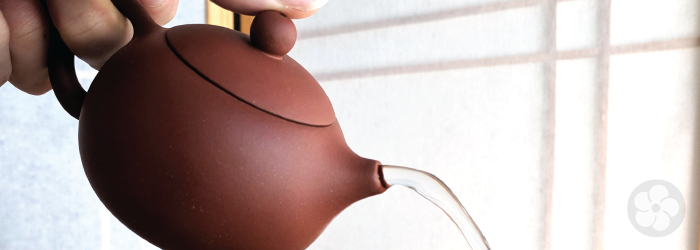Yixing Authenticity: Handmade vs. Slip Cast

Authenticity of Yixing pots is an amorphous concept: defined differently by almost every source, and practically impossible to prove in a finished pot. Experts and serious collectors may debate the quality of different source mines or master artists, but the most commonly discussed variable is the method used to craft the raw clay into a refined teapot. Since crafting methods often leave tell-tale signs in the finished construction, this is used as a measure of quality.
Handmade Teapots
For the purist, these are the only authentic examples of Yixing ware. The stoneware clay found in the deposits around Yixing is dense with minerals like kaolin, quartz, and mica, which are hard and brittle in their natural form. The traditional method of preparing this clay requires the stone to be broken, sifted, mixed with water, and sieved, all to purify the clay until it contains only the finest particles. Finally, the clay is stored and aged to increase plasticity and make it easier to work with.
When the clay is finished, a traditional craftsman will pound it into a thin slab with a wooden mallet. Slabs are trimmed to form several pieces, fit together, and carefully molded with the help of paddles and other rustic tools. Without even a pottery wheel, artists must be experts to obtain the simple, symmetrical shapes that are typical of Yixing teapots. Apprenticeships can last several years, while masters typically devote an entire lifetime to their craft. While it may be the most traditional, this is also the most difficult and method of making a Yixing teapot, and results in the highest prices.
“Half-Handmade” Teapots
This vague term is usually used to describe teapots assembled from press molds. Again, the clay is pounded into a flat slab, but rather than being formed during assembly, pieces of the thin sheet of clay are pressed into mold shapes to form various parts of the teapot. Usually, the body of the teapot is formed in two halves, while the handle, spout, lid, and knob are all pressed as separate pieces. The collection of small parts is then assembled by hand by the artist.
This process allows for repeated designs, and can help a small studio increase their output. It does not change the formulation of the clay, so pots made this way are typically accepted as “authentic” despite the molding step.
Slip Cast Teapots
Yixing pots made with this method are often regarded with suspicion, since it can increase output of identical designs exponentially, and is therefore the method used for most inexpensive, mass-market pots. To slip cast a teapot, the studio must first make a plaster mold of a prototype. Then, the clay is prepared by reducing it to a slip, or slurry. In the most basic sense, this is just adding water to the clay, but for best results the slip must be deflocculated - a step which reduced the amount of water needed to maintain the right consistency. This reduces shrinkage and cracking while the clay dries in the mold, and improves success rates.
Deflocculation is usually achieved with sodium silicate or other ingredients that do not change the texture of the finished pot. Some factories, however, may add ingredients like borosilicate glass, which will produce a thinner, lighter pot, but reduce the porosity of the fired clay and keep it from absorbing tea oils in the same way as traditional Yixing wares.
In many ways, slip casting may also be counted as a “handmade” process, since mold-making still requires the hand of a skilled artisan. Many slip cast pots would also closely fit the “half-handmade” definition, being cast in several pieces and assembled by hand. It is the adulteration of the clay that causes alarm, as the natural properties of Yixing clay may be sacrificed in the name of imitating high quality craftsmanship.
Finding Quality in a Finished Pot
Many sources of Yixing advice will recommend looking for tool marks or seams inside the body of the pot to indicate the crafting method. Unfortunately, these are rarely decisive. For example, a visible seam down the center of the body may indicate the two halves of a slip mold, or it could be where two halves of press-molded clay were joined in a half-handmade process. In reality, high quality examples of any crafting method might not show any such marks, as a careful craftsman will be sure to smooth them away.
Rather than seeking authenticity, it is more practical to consider how the pot will be used. Stroking the lid in a circle around the rim is a common test for clay density, with less porous clays (better for aromatic teas) making a higher, brighter ringing sound. In a similar way, the thickness of the walls plays a part in heat retention, with thicker walls holding more heat for darker teas. When in doubt, look for a smooth pour and a balanced weight. Most of all, remember that the “best” pot is the one that works for you!
What do you look for when choosing a yixing teapot? Let us know in the comments!
Sign up for our newsletter to get blog updates in your inbox!







Comments on this post (2)
What a great explanation of the varying ways of Yixing teapot production. I appreciate the unbiased descriptions and lack of ‘snobbiness’ that can sometimes be found elsewhere. Too often the more economical half handmade or slip cast pots are looked down upon, leaving some tea drinkers feeling left out of the experience because a several hundreds of dollars pot may be beyond their budget. Thank you!
— Kim
Thank you for your interesting description of Yixing teaware. I’ve never had an authentic Yixing teapot – relying on my trusty (and inexpensive) Beehouse pots – but now I will know more about what to look for if I ever do want to acquire a Yixing!
— Pam